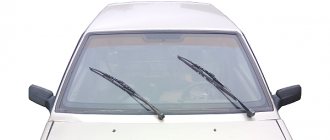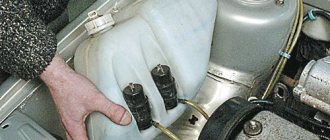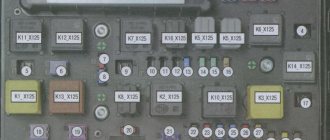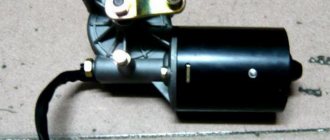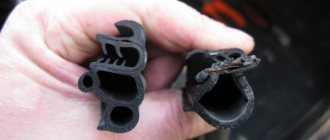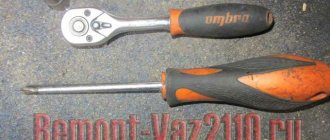Washer reservoir: replacement and part price
The windshield washer reservoir on VAZ 2110-2112 cars has to be changed quite rarely, since there are quite a few reasons why this needs to be done.
And the most common is the appearance of cracks and leakage of washer fluid. This happens, of course, in the winter season, when car owners forget to replace the water with an antifreeze liquid. To avoid such problems and not spend extra money on a new tank, replace the water with non-freezing liquid even before the first frost sets in. To begin with, you can at least use one that can withstand temperatures down to -10 ºC.
If you still did not protect the tank from freezing and cracks appeared in it, you will have to replace it with a new one. You can do all this work yourself using a minimum of tools, namely:
- 10 mm socket head
- Ratchet handle
The first step is to disconnect the power wires from the windshield washer motor, as clearly shown in the photo below.
You should also immediately disconnect the hose from the motor by simply pulling it with a little force:
Now disconnect the power plug from the liquid level sensor and unscrew the plug and remove the sensor:
After this, you can unscrew the bolts securing the tank, one of which is located in the front part:
And there's another one in the back.
And now you can easily remove the tank from its seat, since nothing else holds it:
Then you can install the tank in the reverse order. You can buy a new one for about 150 rubles.
↑ Windshield washer device
Windshield washer
consists of a polyethylene reservoir with an electric pump installed on the left in the engine compartment, washer nozzles located on the hood, and flexible connecting hoses.
The washer is activated by the right steering column switch, and power is supplied to the pump motor and windshield wiper relay, which turns the wiper on at low speed if it has been turned off or was running intermittently.
If the pump malfunctions, it is replaced. Clogged nozzles can be blown in the opposite direction or cleaned with fishing line.
Mechanical reasons for device failure
Conventionally, the reasons why the windshield washer fails can be divided into mechanical and electrical. But most often they are quite simple, sometimes you can even recognize them by sound, or carry out a simple check.
Let's look at the mechanical reasons first:
- It is likely that the mesh of the cup, which is equipped with the washer reservoir of the VAZ 2110, is clogged with dirt or other deposits, which is why the pump cannot pump the liquid. Here, most likely, you will have to remove the tank, and then see whether the glass with the mesh needs a replacement, or a simple rinsing;
- Instead of a special anti-freeze fluid, in the summer they poured ordinary water, and before the onset of cold weather, even after pouring a normal windshield washer, they forgot to remove the water from the hoses. She froze, and accordingly, washing the windshield became impossible. The solution is to warm up the car, leave it in a warm garage with the hood closed and wait until the water melts, then the pump can drive it out;
- In the above situation or under other heavy loads, the windshield washer motor shaft may turn. At the same time, a hum is heard from the motor, but the pump does not supply anything to the windows. If this happens, then only replacing the mechanism will help;
- The hose has just slipped off, and the liquid does not flow through the nozzles, but somewhere past them;
- The hose going to the injectors is pinched;
- The injectors (fittings) are clogged with deposits or dirt. To check this, simply remove the hose from the nozzle and see if liquid flows. Replacing the injectors will help.
↑ Electronic relay 524.3747
The purifier has three operating modes, they are activated by the right steering column switch. Intermittent mode is provided by an electronic relay K2 type 524.3747 installed in the mounting block. This relay also turns on the wiper motor at low speed when the windshield washer is turned on. The relay must ensure that the electric motor is turned on with a frequency of 14±4 cycles per minute at a gearmotor shaft speed of at least 20 min -1, a temperature of 20±5°C and a supply voltage of 14±0.2 V.
When the cleaner operates at low speed in constant mode, the supply voltage is supplied to diametrically opposed brushes. When the cleaner operates at maximum speed, “+” power is supplied to the brush located on the side.
To relieve the load on the contacts of the ignition switch, the cleaner is connected through an additional relay K6 in the mounting block.
It is recommended to replace a faulty gearmotor with a new one (cleaning the commutator, limit switch contacts and replacing gears is possible). Bent levers are straightened. When the hinges wear out, they are replaced.
Cause of failure due to electrical
Electrical causes may be:
- The fuse may have blown. It is located in the fuse box;
- Check the leads that are equipped with the VAZ 2110 washer motor; it is quite possible that they have oxidized. It happens that the terminals completely fall off;
- The windshield washer switch located on the steering wheel does not work. Its performance can be easily checked with a multimeter;
- Wiring faulty. The wires may need to be replaced;
- The windshield washer relay does not work. The best treatment is also replacement.
↑ Windshield wiper
1 — rear armature shaft bushing; 2 — felt ring; 3 — electric motor housing; 4 - permanent magnet; 5 – anchor; 6 – collector; 7 — traverse with brush holders, chokes and thermobimetallic fuses; 8 — front armature shaft bushing; 9 — panel with noise-suppressing capacitors and limit switch contacts; 10 — block of intermediate gears; 11 – cover; 12 — gear housing; 13 — driven gear; 14 — output shaft of the gearmotor; 15 — block of intermediate gears
Removing the tank
To remove the windshield washer reservoir, you need to do the following:
- Disconnect the negative terminal from the battery;
- Disconnect the block from the liquid level sensor;
- Disconnect the pads from the windshield washer pump electric motor. When reassembling, remember that a block with a pink wire is connected to the positive terminal, and a block with black wires is connected to the negative terminal;
- If the tank is full, you need to unscrew its cap and remove the cup with the filter mesh;
- Unscrew the fastening nut and bolt. Do not lose sight of the fact that there is a washer installed under the head of the bolt securing the windshield washer reservoir;
- Remove the tank from the studs by lifting it up;
- If there is liquid in it, cover the hole and disconnect the hose from the fitting;
- This liquid is reusable, so it is advisable to drain it into a clean container.
Increasing the volume of washer fluid on VAZ 2112, 2111, 2110
The windshield washer reservoir on domestic cars does not have a very large volume and in the autumn or summer three liters is clearly not enough. This problem is easily solved by installing an additional fluid reservoir. If we compare the barrel from a VAZ 2110 with the barrel on a Lada Samara, then the latter has a volume of 5.2 liters, and in this case it is the barrel with this volume that will serve as an additional one. In this case, it will be installed next to the adsorber, and having moved it in advance.
In addition to the barrel, you will also need a motor, a fluid level sensor, a washer hose, three wires, corrugated protection, mounting brackets, bolts, nuts, washers, electrical connectors, tips and a brake pipe. It is impossible to immediately install the barrel after the right wing, because the adsorber is installed there; it needs to be moved in this case. It is best installed on the front pillar cup. Fastening is carried out on 2 studs, which are found on the mounting holes for the standard washer reservoir of VAZ 2112, 2111, 2110, as well as the optics hydraulic corrector tubes. The mount will need to be slightly adjusted to the new location; we cut out the bracket at the top and bottom in those places where there is resistance welding. Then you need to make several holes and secure everything.
After the adsorber has been moved, the next problem arises - the brake pipe. You cannot bend it to the side, because it has a certain size. In this case, it is necessary to replace it with a long one. After the new tube has been installed, you need to bleed the brake system to remove air from there. You need to connect the previously moved adsorber. The two adsorber wires must be disconnected from the wiring harness, which is located under the power unit.
After this, you need to put on the previously prepared corrugated tube. The tube that goes from the tank to the adsorber needs to be relocated; now it will pass at the bottom along with the brake pipes. The excess length of the rubber hose that goes from the adsorber to the throttle pipe must be carefully cut off. So, the adsorber has been moved, but in the old place there are studs that secured it, and they need to be carefully cut off.
To attach the tank you need to have two holes with a diameter of 6 mm. Then the installed additional barrel needs to be connected. The negative wire must be installed near the electric motor, and 2 wires from the motor and from the sensor must be inserted into a plastic corrugation. The new bundle of wires must be connected to all the wires that pass there and everything must be carefully installed in the engine compartment of the VAZ 2112, 2111, 2110. After this, you need to make a hole for the harness in the soundproofing of the engine shield.
Now the wiring will go into the car interior along with all the wires from the stove. To simplify the task as much as possible, you can completely remove the windshield wiper trapezoid. In the cabin, the wiring will appear under the dashboard above the mounting block. The wires need to be connected to 13-pin connectors, which can be found on the left side of the mounting block. The red wire must be connected to the BSK unit. The signal in this case is the wear of the front brake pads. The additional fluid reservoir will be connected automatically when the fluid is mostly empty.
Checking the motor
If there is liquid in the windshield washer, but it does not come from the nozzles, you need to check whether the pump electric motor is working. If it is in good condition, check the fuse, as well as the wiring, for which, after de-energizing the battery and disconnecting the pads from the pump motor (as described above), you need to connect the pump motor terminals directly to the battery terminals, observing the polarity. If the pump still does not work, it needs replacement, which is usually done complete with the motor.
To make the replacement, you also need to first remove the windshield washer reservoir, and carefully pry off the pump with a screwdriver, and then remove it. It is easy to install a new pump, but before doing so it is highly advisable to replace its rubber seal.
Device Features
There are new and old motors. The latter can be found on Soviet cars, or on VAZ 2107, 2108, for example.
Most cars, including the VAZ 2109, 2110, 2114, as well as foreign cars Mitsubishi Lancer, Pajero Sport or Ford Focus, already use new types of washer motors (pumps).
The main components of the washer are:
- nozzles;
- pump (motor);
- reservoir with washer fluid.
Nozzles are used to supply water to the windshield of a car. Therefore, they should be positioned so that the outgoing stream of liquid hits the center of the headplate as much as possible. The pump supplies water to the tank. By the way, on some cars, wash water is supplied not only to the windshield, but also to the main headlights in front and behind.
Replacing windshield washers on VAZ-2110, 2111, 2112
A windshield washer is one of the most useful inventions that is designed to simplify the life of a car enthusiast. As long as the unit works properly and clearly performs its functions, rarely anyone pays attention to it. But as soon as the windshield washer fails, operational problems immediately appear.
For example, in wet weather, driving behind any vehicle leads to rapid contamination of the glass surface. As a result, visibility becomes zero. If the washer is working properly, then a few simple manipulations solve the problem. And if not? In such a situation, you have to stop the car every 100-200 meters and wash the windshield manually.
↑ Wiring diagram for the windshield washer and wiper of the VAZ 2110
1 - electric motor for windshield wiper; 2 — windshield washer electric motor; 3 — windshield wiper and washer switch; 4 — mounting block; 5 — ignition switch; K2 - windshield wiper relay; K6 - additional relay; A - conventional numbering of plugs in the block of the wiper motor; B - to power supplies
↑ Removing and disassembling the windshield wiper
- Disconnect the negative cable from the battery.
- Remove the trim and trim of the wind window (see Removing the trim and trim of the wind window).
- Remove the expansion tank (see Removing the expansion tank).
- Disconnect the wiper gear motor connector.
- Using a 10mm wrench, unscrew the nuts on the left and right securing the wiper to the body, as well as one bolt securing the gearmotor bracket.
- Remove the cleaner from the studs and remove it from the air supply box.
- Using a 13mm wrench, unscrew the crank fastening nut.
- Using a 10mm wrench, unscrew the three bolts securing the gearmotor to the bracket and remove it.
- Use a Phillips screwdriver to unscrew the two screws securing the protective cap.
- We remove the cap.
- Using a Phillips screwdriver, unscrew the four screws securing the gear motor cover and remove it.
- If necessary, replace the gear motor gears and clean the limit switch contacts.
